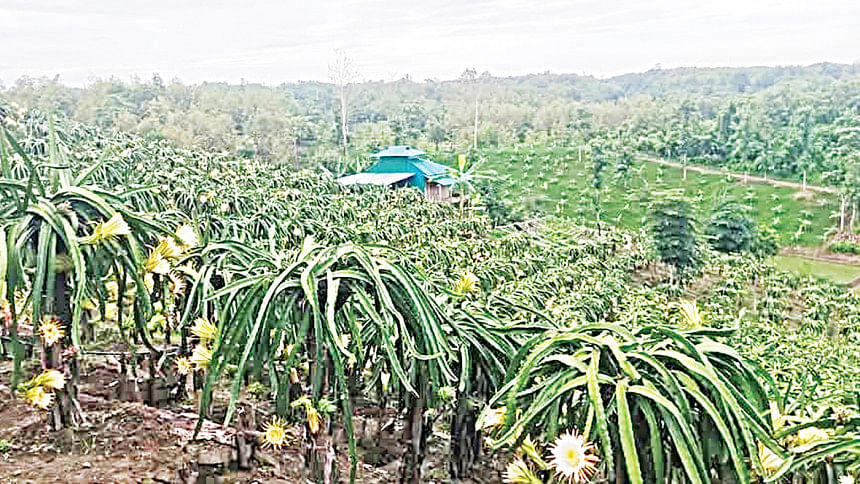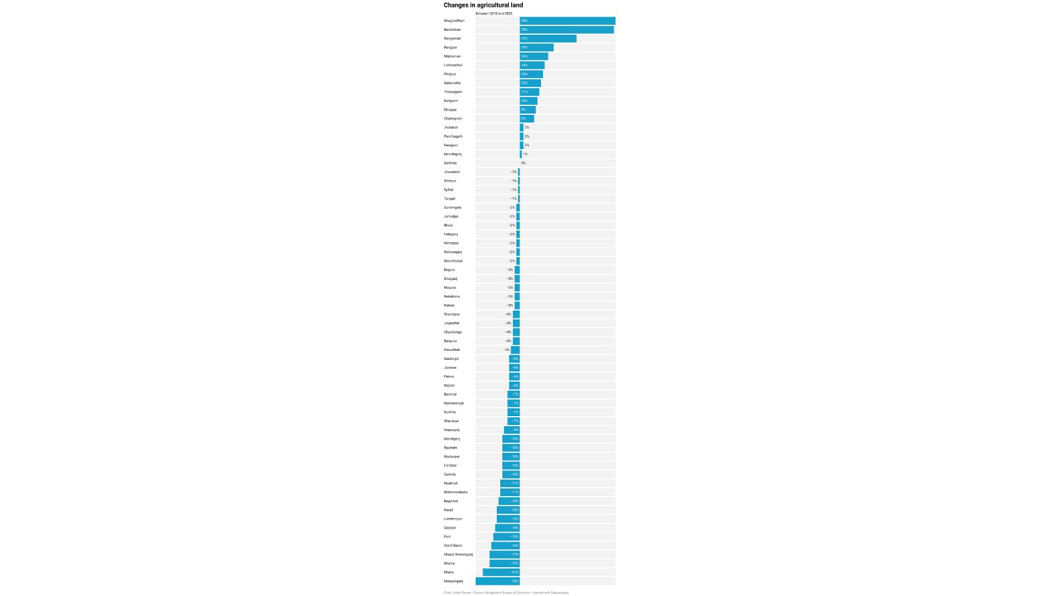Farmland expands in 16 districts, defying national decline

Bangladesh is losing farmland. There are multiple reasons behind the shrinkage—from the construction of homes and the establishment of factories to the development of other facilities. This has caused many to call for the formulation of rules for the preservation of agricultural land so that the nation can produce its own food, especially staple rice.
But the loss of agricultural land is only part of the story. New land is also coming under farming, according to the Bangladesh Environmental Statistics 2024, released by the Bangladesh Bureau of Statistics (BBS) at the end of last month.
It says 16 districts recorded farming on an increased area of land between 2015 and 2023, even though the country lost 2 percent of agricultural land to other purposes during the period.
As of 2023, Bangladesh had 72,915 square kilometres of agricultural land, having lost 1,470 square kilometres since 2015.

But during this period, Khagrachhari, a hill district in the southeastern region, saw the highest surge of 54 percent in farming area to 603 square kilometres in 2023, followed by Bandarban and Rangamati, two other hill districts.
In Bandarban, land under agricultural use grew by 53 percent to 588 square kilometres in 2023.
Rangamati registered a 32 percent increase in agricultural area to 521 square kilometres since 2015 as people in the hill tracts began to grow crops on lands that had remained fallow earlier.
Sarbottom Chakma, a resident of Khagrachhari, is one of them. Prior to 2015, he used to practise jhum, a traditional method of cultivation, on a fraction of his land and kept most of his land uncultivated.
He later began to focus on cultivation and gradually brought 25 acres of land under farming, encouraged by profits from crops.
"The lands were completely left unused. Now I have mango, banana, and orange orchards, apart from taro or taro roots," he said.
Like Sarbottom, many of his relatives expanded cultivation of commercially lucrative crops in the region.
Md Abdul Muyeed, a former director general of the Department of Agricultural Extension (DAE), said there are 700,000 hectares (one hectare equals 0.01 square kilometres) of fallow land in the hill tracts region.
"These lands are coming under farming. We see many orchards in the area now, and fruits such as dragon fruit, papaya, and pineapple are grown commercially there," he said.
Besides, a good portion of sandbars or char areas in the country's northwestern region—for example, Gaibandha district—was left uncultivated in the past. This was due to a lack of irrigation and agricultural technology there.
"Now, people in the char areas irrigate croplands using hose pipes. Farmers also store water for irrigation by making small reservoirs in these areas," he said.
"Various crops, namely pumpkins, are grown there now. So, the introduction of new agricultural technology has given an impetus to farming in these areas," he said.
According to the BBS data, nine districts in the northwest recorded an expansion of land under agriculture.
Rangpur saw the highest expansion at 19 percent to 1,738 square kilometres in 2023 from that in 2015, followed by Nilphamari and Lalmonirhat.
In the southern region, land under agricultural use increased by 13 percent in Pirojpur, followed by 8 percent in Chattogram and 2 percent in Jhalakathi.
Farmlands in the rest of the 48 districts declined. Narayanganj suffered the highest loss, followed by Dhaka and Khulna.
Land under agricultural use slumped 25 percent to 227 square kilometres in 2023 from 305 square kilometres eight years ago. Dhaka lost 21 percent of land, falling to 514 square kilometres in 2023, says the BBS.
Md Mamunur Rahman, chief scientific officer of the Soil Resource Development Institute (SRDI), said they found in a study that Bangladesh loses 0.73 percent of agricultural land annually to non-farm use.
"But overall agriculture has not declined because yields have increased," he said, suggesting a law to protect farmlands.
Food and Land Affairs Adviser Ali Imam Majumdar said, "We see a lot of farmlands being converted into fishery farms. Should we term those agricultural areas?"
He said a panel of four advisers has been formed to prepare a law for the protection of agricultural land, especially for cereal crops, and the advisers have given some inputs to the officials concerned for review.
"I expect that we can sit in the middle of August to discuss the law. We are a small country with a huge population. This is the main problem in Bangladesh," he said.

 For all latest news, follow The Daily Star's Google News channel.
For all latest news, follow The Daily Star's Google News channel. 



Comments